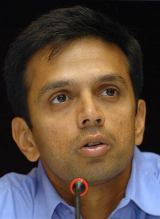A sordid relationship
What was billed as media interaction day with the Indian cricket team instead became a fiasco of a press conference punctuated by awkward silences and media inaction
|
|

|
What was billed as media interaction day with the Indian cricket team instead became a fiasco of a press conference punctuated by awkward silences and media inaction. As the players stared with increasing incredulity, the vast majority of the print media kept their heads down, or stared at the high walls, showing their displeasure at the management decision to turn private tête-à-têtes into a free-for-all.
Those who had prepared over 50 questions the previous night - around three per player - were in for a rude shock when they reached the banquet hall at the Pearl Continental in the morning. Instead of round tables where a couple of players and four or five journalists could seat themselves and have questions answered, there were 16 chairs set in a row for the team, with seats laid out for the media as they would be at a routine press conference. When it was mentioned to GS Walia, the media manager, that this was not how media interaction sessions were carried out, he expressed the view that this was how the team, and especially the captain, wanted it. His view was echoed by Raj Singh Dungarpur, the team manager, though a team source later told Cricinfo that neither Rahul Dravid nor his team had any idea about the change in plan.
With animated discussions producing absolutely no compromise, the media interaction that was a press conference in all but name started with players gazing expectantly at a group of disinterested faces. With pindrop silence reigning, a couple of journalists broke rank and started asking questions, oblivious to the hostility from their colleagues. Each question would be followed by an eerie silence that spoke volumes, and we were finally left with the laughable sight of a journalist asking players like Wasim Jaffer and RP Singh if they had anything to volunteer.
You felt for the players, who looked bemused to be part of such a charade. By the time it ended over half an hour later, with more pauses than questions, everyone had lost out. Journalists who had sat up late into the night compiling a bank of questions to be used at various stages over the tour, were left with nothing, the fringe players who might otherwise have had a piece or thirty written about them at some stage were denied that chance, and most importantly, the readers were deprived of a little more insight behind the scenes of a tour that holds more interest than perhaps any other.
Given that players are loathe to be disturbed with one-on-one interview requests in the middle of a series, media interaction day assumes paramount importance. It went off without a hitch on both of Australia's recent tours of India - for the TVS Cup in 2003 and the Test series in 2004 - and was organised beautifully by Amrit Mathur, the media manager, and Prof. Ratnakar Shetty, the manager, at Multan on India's last tour here. Why such an arrangement - surely not in the realms of rocket science - couldn't be ensured here is something for the media manager to explain.
There was some innuendo that such a decision was the result of the team management's reluctance to front up to questions about Sourav Ganguly's participation, or not, in the Lahore Test. But instead of firefighting, the new arrangement merely fanned the flames, and both Dravid and Ganguly had to field extremely awkward questions about the composition of the team. The tension writ across each man's face showed exactly why the Ostrich-head-in-sand approach had failed miserably.
Another source within the team reckoned that the decision to do away with one-on-ones had been taken by players who had signed exclusive media deals before the series. If that was the case, it was as pathetic as it was sad. The same players, when out in the cold, can be found calling up journalists begging for a sympathetic hearing. If they subsequently find no joy, such attitudes have much to do with it.
People often mention how harsh the Indian media can be on its players, especially when compared to its Australian counterpart. But the players who wear baggy green, with an exception or two, treat their journalists as equals, as professionals doing another job. Respect is a two-way street, and until the Indian team's media management imbibes some of the on-field professionalism, the relationship between player and scribe appears destined to be characterised by a disconnect and distrust that serves neither party.
Dileep Premachandran is features editor of Cricinfo